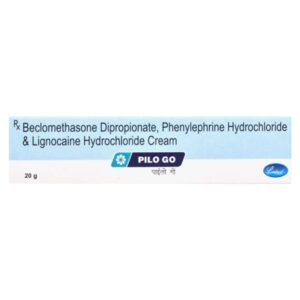BECLOMETHASONE + PHENYLEPHRINE + LIDOCAINE (LIGNOCAINE OR XYLOCAINE)
Beclomethasone: Beclomethasone is a medication that belongs to the class of drugs known as corticosteroids. It is used as an inhaler for the prevention and control of symptoms in patients with asthma or other breathing disorders. Beclomethasone helps reduce the inflammation and swelling in the airways, allowing for easier breathing.
The medication works by binding to glucocorticoid receptors in the cells, which leads to the activation or repression of certain genes involved in the inflammatory response. This ultimately reduces the production of pro-inflammatory substances, such as cytokines and leukotrienes, and inhibits the infiltration of immune cells into the airways.
Beclomethasone is typically prescribed as an inhaler, with the recommended dose depending on the severity of the patient’s condition. The dosage may vary between individuals, but a common starting dose for adults is 100-200 micrograms twice daily. The dose may be adjusted by the healthcare professional based on the individual’s response and the severity of symptoms.
Like any medication, Beclomethasone can cause side effects. Common side effects include a sore throat, cough, hoarseness, or dry mouth. These effects are usually mild and can be minimized by rinsing the mouth and gargling with water after each use of the inhaler. Prolonged use of high doses may increase the risk of systemic side effects, such as adrenal suppression, growth suppression in children, osteoporosis, and increased susceptibility to infections. It is important to use Beclomethasone as prescribed and discuss any concerns or side effects with a healthcare professional.
Phenylephrine: Phenylephrine is a medication that is primarily used as a nasal decongestant, but it can also be used as a vasopressor to increase blood pressure in certain medical conditions.
Mechanism of Action:
Phenylephrine acts as an alpha-1 adrenergic agonist, which means it stimulates receptors in the smooth muscles of blood vessels, causing constriction. This constriction leads to a decrease in nasal congestion and an increase in blood pressure.
Use:
Phenylephrine is commonly used to provide temporary relief from nasal congestion caused by allergies, colds, and sinusitis. It is available both over-the-counter and in prescription-strength formulations. Additionally, it can be used intravenously in emergency situations to raise blood pressure in patients with shock, low blood volume, or low blood pressure.
Dose:
The dosage of phenylephrine depends on the formulation and the reason for its use. For nasal congestion, it is typically applied as a nasal spray with 0.125-0.25% solution strength, and the recommended dose is 2-3 sprays in each nostril every 4 hours, up to a maximum of 12 sprays in 24 hours. For intravenous use, the dose varies based on the patient’s weight, blood pressure, and overall health and is typically administered by a healthcare professional.
Side Effects:
Common side effects of phenylephrine can include headache, dizziness, nervousness, restlessness, increased heart rate, increased blood pressure, nausea, and insomnia. Rare but more severe side effects can include difficulty breathing, chest pain, irregular heartbeat, hallucinations, and seizures. It’s important to follow the recommended dosage and seek medical attention if any concerning side effects occur. Phenylephrine should be used with caution in individuals with cardiovascular disease, high blood pressure, diabetes, thyroid disease, or those taking certain medications. It should not be used in patients with severe damage to the heart muscle or coronary artery disease. As always, it’s best to consult a healthcare professional before using any medication.
Lidocaine (lignocaine Or Xylocaine): Lidocaine, also known as lignocaine or Xylocaine, is a local anesthetic medication commonly used to numb and relieve pain in various medical procedures. It belongs to the class of medications known as amide local anesthetics.
Lidocaine works by blocking the transmission of pain signals from the nerves to the brain. It does this by inhibiting the voltage-gated sodium channels in the cell membranes of the nerves, preventing the sodium ions from entering the cell. This action prevents the nerve from generating and transmitting pain signals, resulting in numbness and pain relief in the affected area.
The drug is available in various forms, including creams, ointments, gels, injections, and patches.
The use of Lidocaine is widespread and includes:
1. Local anesthesia for minor surgical procedures, such as dental work, skin biopsies, and suturing of wounds.
2. Topical application to relieve pain and itching caused by conditions like sunburns, insect bites, and minor burns.
3. Use in certain medical procedures, such as inserting central lines, arterial lines, or urinary catheters, to minimize discomfort.
4. Treatment for certain cardiac arrhythmias, as it can be administered intravenously to stabilize abnormal heart rhythms.
The dose of Lidocaine varies depending on the route of administration and the specific procedure being performed. The healthcare provider will determine the appropriate dose for each individual based on factors such as age, weight, and the patient’s overall health.
While Lidocaine is generally safe to use, it may cause some side effects. Common side effects include temporary numbness, skin redness or irritation at the application site, and a burning or stinging sensation. In rare cases, more severe side effects may occur, such as allergic reactions, difficulty breathing, dizziness, confusion, blurred vision, or irregular heartbeat. If any of these serious side effects occur, it is important to seek immediate medical attention.
Overall, Lidocaine is an effective and commonly used local anesthetic medication, providing temporary pain relief in a wide range of medical procedures and conditions. However, it should only be used under the guidance of a healthcare professional.

